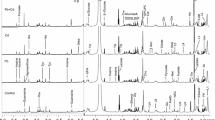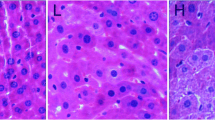Abstract
The Procapra przewalskii inhabits in a selenium (Se)-deprived environment in long-term, but they have no pathological manifestations due to the Se deprivation. This study aimed to reveal the underlying adaptation induced by Se deprivation. In the analysis, a total of 93 significantly changed metabolites were identified in positive and negative ion modes, including 46 upregulated and 47 downregulated compounds in the Se-deprived group. The differential metabolites were annotated as the major molecules in bile acid biosynthesis, biosynthesis of unsaturated fatty acids, and pyrimidine metabolism, respectively. This study systematically analyzed the serum metabolomics characteristics of P. przewalskii under Se-deprived conditions for the first time, providing a basis for further understanding of the metabolic mechanism of P. przewalskii in the Se-deprived environment.





Similar content being viewed by others
References
Hu J, Jiang Z (2011) Climate change hastens the conservation urgency of an endangered ungulate. PLoS One 6(8):e22873. https://doi.org/10.1371/journal.pone.0022873
Wang Y, Du S, Yang Y, Zhang X, Duszynski DW, Bian J, Cao Y (2016) Intestinal parasites in the critically endangered Przewalski’s Gazelle ( Procapra przewalskii ) in China, with the description of a new species of eimeria (Apicomplexa: Eimeriidae). J Wildl Dis 52:945–948. https://doi.org/10.7589/2016-03-062
Li C, Jiang Z, Fang H, Li C (2013) A spatially explicit model of functional connectivity for the endangered Przewalski’s gazelle (Procapra przewalskii) in a patchy landscape. PLoS One 8(11):e80065. https://doi.org/10.1371/annotation/8cf2e747-87cb-4415-87ae-d643f63b6288
Yu H, Song S, Liu J, Li S, Zhang L, Wang D, Luo SJ (2017) Effects of the Qinghai-Tibet railway on the landscape genetics of the endangered Przewalski’s gazelle (Procapra przewalskii). Sci Rep 7(1):17983. https://doi.org/10.1038/s41598-017-18163-7
Li C, Jiang Z, Li L, Li Z, Fang H, Li C, Beauchamp G (2012) Effects of reproductive status, social rank, sex and group size on vigilance patterns in Przewalski's gazelle. PLoS One 7(2):e32607. https://doi.org/10.1371/journal.pone.0032607
Boussada M, Ali RB, Chahbi A, Abdelkarim M, Fradj MKB, Dziri C, Bokri K, Akacha AB, May MVE (2019) A new thiocyanoacetamide protects rat sperm cells from Doxorubicin-triggered cytotoxicity whereas selenium shows low efficacy: in vitro approach. Toxicol In vitro 61(C):104587. https://doi.org/10.1016/j.tiv.2019.06.021
Shen XY, Chi YK, Xiong KN (2020) The effect of heavy metal contamination on humans and animals in the vicinity of a zinc smelting facility. PLos One 14(10):e0207423. https://doi.org/10.1371/journal.pone.0207423
Kieliszek M, Blazejak S (2016) Current knowledge on the importance of selenium in food for living organisms: a review. Molecules 21(5):609. https://doi.org/10.3390/molecules21050609
Zhao K, Huo B, Shen XY (2021) Studies on antioxidant capacity in selenium-deprived the Choko yak in the Shouqu prairie. Biol Trace Elem Res 199(1-4):3297–3302. https://doi.org/10.1007/s12011-020-02461-9
Huo B, He J, Shen XY (2020) Effects of selenium-deprived habitat on the immune index and antioxidant capacity of Przewalski’s Gazelle. Biol Trace Elem Res 198(4):149–156. https://doi.org/10.1007/s12011-020-02070-6
Song CJ, Qing J, Shen XY (2021) Responses of Przewalski’s gazelle (Procapra przewalskii) to zinc nutrition in physical habitat. Biol Trace Elem Res 199(2):142–147. https://doi.org/10.1007/s12011-020-02137-4
Song CJ, Shen XY (2020) Effects of environmental zinc deficiency on antioxidant system function in Wumeng semi-fine wool sheep. Biol Trace Elem Res 195(1):110–116. https://doi.org/10.1007/s12011-019-01840-1
Shen XY, Min XY, Zhang SH, Song CJ, Xiong KN (2020) Effect of heavy metal contamination in the environment on antioxidant function in Wumeng semi-fine wool sheep in southwest China. Biol Trace Elem Res 198(1):505–514. https://doi.org/10.1007/s12011-020-02081-3
Wu T, Shen XY (2020) Response of Wumeng semi-fine wool sheep to copper-contaminated environment. Pol J Environ Stud Environ. Stud. 2020;29(4):2917–2924. 10.15244/pjoes/111881.
Li YF, Liu HW, He J, Shen XY, Zhao K, Wang YC (2021) The effects of oral administration of molybdenum fertilizers on immune function of Nanjiang brown goat grazing on natural pastures contaminated by mixed heavy metal. Biol Trace Elem Res. https://doi.org/10.1007/s12011-021-02901-0
Zhai BW, Zhao K, Shen XY (2021) Effects of sulphur fertilizer on copper metabolism in grazing Tibetan sheep in fertilized pasture. Pol J Environ Stud. 10.15244/pjoes/136011.
Li YF, Wang YC, Shen XY, Liu FY (2021) The combinations of sulfur and molybdenum fertilizations improved antioxidant capacity of grazing Guizhou semi-fine wool sheep under copper and cadmium stress. Ecotox Environ Safe 222. https://doi.org/10.1016/J.ECOENV.2021.112520
Li YF, He J, Shen XY (2021) Effects of foliar application of nano-molybdenum fertilizer on copper metabolism of grazing Chinese merino sheep (Junken Type) on natural grasslands under copper and cadmium stress. Biol Trace Elem Res. https://doi.org/10.1007/s12011-021-02889-7
Huo B, Wu T, Song CJ, Shen XY (2020) Studies of selenium deficiency in the Wumeng semi-fine wool sheep. Biol Trace Elem Res 194(1):1–7. https://doi.org/10.1007/s12011-019-01751-1
Xu SW, Yao HD, Zhang J, Zhang ZW, Wang JT, Zhang JL, Jiang ZH (2013) The oxidative damage and disbalance of calcium homeostasis in brain of chicken induced by selenium deficiency. Biol Trace Elem Res 151(2):225–233. https://doi.org/10.1007/s12011-012-9552-0
Huo B, Shen XY (2020) Study of rickets and osteomalacia in Tibetan gazelle. Pak J Zool 52(5): 1751-1759. 10.17582/journal.pjz/20190901110943.
Shen XY, Song CJ (2021) Responses of Chinese merino sheep (Junken Type) on copper-deprived natural pasture. Biol Trace Elem Res 199(4):989–995. https://doi.org/10.1007/s12011-020-02214-8
Liu J, Jiang Y, Huang C, Fang H, Fang H, Pang W (2010) Proteomic analysis reveals changes in the hippocampus protein pattern of rats exposed to dietary zinc deficiency. Electrophoresis 31(8):1302–1310. https://doi.org/10.1002/elps.200900733
Chan YH, Siu CW, Yiu KH, Chan HT, Li SW, Tam S, Cheung BM, Lau CP, Lam TH, Tse HF (2012) Adverse systemic arterial function in patients with selenium deficiency. J Nutr Health Aging 16(1):85–88. https://doi.org/10.1007/s12603-011-0086-5
Deger Y, Mert H, Mert N, Yur F, Kozat S, Yoruk IH, Sel T (2008) Serum selenium, vitamin E, and sialic acids concentrations in lambs with white muscle disease. Biol Trace Elem Res 121(1):39–43. https://doi.org/10.1007/s12011-007-0063-3
Li YF, He J, Shen XY (2020) Effects of nano-selenium poisoning on immune function in the Wumeng semi-fine wool sheep. Biol Trace Elem Res 199(8):2919–2924. https://doi.org/10.1007/s12011-020-02408-0
Zhao K, Chi YK, Shen XY (2020) Studies on edema pathema in Hequ horse in the Qinghai-Tibet plateau. Biol Trace Elem Res 198(1):142–148. https://doi.org/10.1007/s12011-020-02043-9
Peng S, Yan L, Zhang J, Wang Z, Tian M, Shen H (2013) An integrated metabonomics and transcriptomics approach to understanding metabolic pathway disturbance induced by perfluorooctanoic acid. J Pharm Biomed Anal 86(4):56–64. https://doi.org/10.1016/j.jpba.2013.07.014
Nicholson JK, Lindon JC, Holmes E (1999) 'Metabonomics’: understanding the metabolic responses of living systems to pathophysiological stimuli via multivariate statistical analysis of biological NMR spectroscopic data. Xenobiotica 29(11):1181–1189. https://doi.org/10.1080/004982599238047
Sreekumar A, Poisson LM, Rajendiran TM, Khan AP, Cao Q, Yu J, Laxman B, Mehra R, Lonigro RJ, Li Y, Nyati MK, Ahsan A, Kalyana-Sundaram S, Han B, Cao X, Byun J, Omenn GS, Ghosh D, Pennathur S et al (2009) Metabolomic profiles delineate potential role for sarcosine in prostate cancer progression. Nature 457(7231):910–914. https://doi.org/10.1038/nature07762
Mamas M, Dunn WB, Neyses L, Goodacre R (2011) The role of metabolites and metabolomics in clinically applicable biomarkers of disease. Arch Toxicol 85(1):5–17. https://doi.org/10.1007/s00204-010-0609-6
Wu T, He J, Shen XY (2021) Study of metabolomics in selenium deprived Przewalski’s gazelles (P. przewalskii). Brit J Nutr 1-29. https://doi.org/10.1017/S000711452100355X
Paris LP, Johnson CH, Aguilar E, Usui Y, Cho K, Hoang LT, Feitelberg D, Benton HP, Westenskow PD, Kurihara T, Trombley J, Tsubota K, Ueda S, Wakabayashi Y, Patti GJ, Ivanisevic J, Siuzdak G, Friedlander M (2016) Global metabolomics reveals metabolic dysregulation in ischemic retinopathy. Metabolomics 12(1):15. https://doi.org/10.1007/s11306-015-0877-5
Emwas AH (2015) The strengths and weaknesses of NMR spectroscopy and mass spectrometry with particular focus on metabolomics research. Methods Mol Biol 1277:161–193. https://doi.org/10.1007/978-1-4939-2377-9_13
Li YF, He J, Luo L, Wang YC (2021) The combinations of sulfur and molybdenum fertilization improved antioxidant capacity in grazing Nanjiang brown goat. Biol Trace Elem Res 14:1–9. https://doi.org/10.1007/s12011-021-02702-5
Tang QY, Zhang CX (2013) Data processing system (DPS) software with experimental design, statistical analysis and data mining developed for use in entomological research. Insect Sci 20(2):254–260. https://doi.org/10.1111/j.1744-7917.2012.01519.x
Shen XY, Huo B, Wu T, Song CJ, Chi YK (2019) iTRAQ-based proteomic analysis to identify molecular mechanisms of the selenium deficiency response in the Przewalski’s gazelle. J Proteomics 203:103389. https://doi.org/10.1016/j.jprot.2019.103389
Khoso PA, Yang Z, Liu C, Li S (2015) Selenoproteins and heat shock proteins play important roles in immunosuppression in the bursa of Fabricius of chickens with selenium deficiency. Cell Stress Chaperon 20(6):967–978. https://doi.org/10.1007/s12192-015-0625-9
Klaassen CD, Aleksunes LM (2010) Xenobiotic, bile acid, and cholesterol transporters: function and regulation. Pharmacol Rev 62(1):1–96. https://doi.org/10.1124/pr.109.002014
Mickiewicz B, Villemaire ML, Sandercock LE, Jirik FR, Vogel HJ (2014) Metabolic changes associated with selenium deficiency in mice. Biometals 27(6):1137–1147. https://doi.org/10.1007/s10534-014-9774-z
Beckett GJ, Glass EJ, Callaghan MO, Elton RA, Hume R (1985) Measuring bile-salt concentrations lacks clinical value for detecting hepatic dysfunction in infants receiving parenteral nutrition. Clin Chem 31(7):1168–1171. https://doi.org/10.1093/clinchem/31.7.1168
Domenichiello AF, Kitson AP, Bazinet RP (2015) Is docosahexaenoic acid synthesis from α-linolenic acid sufficient to supply the adult brain? Prog Lipid Res 59:54–66. https://doi.org/10.1016/j.plipres.2015.04.002
Kieliszek M, Blazejak S, Bzducha-Wrobel A, Kot AM (2019) Effect of selenium on lipid and amino acid metabolism in yeast cells. Biol Trace Elem Res 187(1):316–327. https://doi.org/10.1007/s12011-018-1342-x
Francis G, Makkar HPS, Becker K (2001) Antinutritional factors present in plant-derived alternate fish feed ingredients and their effects in fish. Aquaculture 199(3-4):197–227. http://doi.org/. https://doi.org/10.1016/S0044-8486(01)00526-9
Sun HY, Clish CB, Gladyshev VN (2019) Selenium deficiency is associated with pro-longevity mechanisms. Cell Rep 27(9):2785–2797.e3. https://doi.org/10.1016/j.celrep.2019.05.001
Grohmann K, Lauffer H, Lauenstein P, Hoffmann GF, Seidlitz G (2015) Hereditary orotic aciduria with epilepsy and without megaloblastic anemia. Neuropediatrics 46(02):123–125. https://doi.org/10.1055/s-0035-1547341
Kimura T, Yasuda K, Yamamoto R, Soga T, Rakugi H, Hayashi T, Isaka Y (2016) Identification of biomarkers for development of end-stage kidney disease in chronic kidney disease by metabolomic profiling. Sci Rep-UK 6:26138. https://doi.org/10.1038/srep26138
Miller RA, Buehner G, Chang Y, Harper JM, Sigler R, Smith-Wheelock M (2005) Methionine-deficient diet extends mouse lifespan, slows immune and lens aging, alters glucose, T4, IGF-I and insulin levels, and increases hepatocyte MIF levels and stress resistance. Aging cell 4(3):119–125. https://doi.org/10.1111/j.1474-9726.2005.00152.x
Wyss M, Kaddurah-Daouk R (2000) Creatine and creatinine metabolism. Physiol Rev 80(3):1107–1213. https://doi.org/10.1111/j.1474-9726.2005.00152.x
Ye YT, Wang YL, CaiCF DXF, Jiang R (2007) Effects of the L-glutamine on the absorption of L-leucine, L-proline and the protein synthesis in intestine of grass carp (Ctenopharyngodon idellus) in vitro. Chin J Ani Nutr 01:28–32 http://doi:cnki:sun:dwyx.0.2007-01-005
Shen XY, Huo B, Gan SQ (2021) Effects of nano-selenium on antioxidant capacity in Se-deprived Tibetan gazelle (Procapra picticaudata) in the Qinghai-Tibet plateau. Biol Trace Elem Res 199(1–4):1–8. https://doi.org/10.1007/s12011-020-02206-8
Huo B, Wu T, Song CJ, Shen XY (2020) Effects of selenium deficiency in the environment on antioxidant systems of Wumeng semi-fine wool sheep. Pol J Environ Stud 29(2):1649–1657. https://doi.org/10.15244/pjoes/109492
Funding
This work was supported by the National Natural Science Foundation of China (Grant No:42171060) and the Innovation and Development Supporting Plan Project of Key Industries in Southern Xinjiang (2021DB014).
Author information
Authors and Affiliations
Contributions
Conceptualization, QL.Z.; methodology, QL.Z. and K.Z.; software, QL.Z. and K.Z.; validation, QL.Z., K.Z., and XY.S.; formal analysis, QL.Z. and K.Z.; investigation, QL.Z. and XY.S.; resources, QL.Z.; data curation, QL.Z. and K.Z.; writing—original draft preparation, QL.Z., K.Z., and XY.S.; writing—review and editing, QL.Z., K.Z., and XY.S.; visualization, QL.Z. and K.Z.; supervision, QL.Z. and K.Z.; project administration, QL.Z, K.Z., and XY.S.; funding acquisition, XY.S. All authors have read and agreed to the published version of the manuscript.
Corresponding author
Ethics declarations
Ethical Standards
All experiments were carried out in accordance with the Guide for the Care and Use of Animals in Agricultural Research and Teaching Consortium (Federation of Animals Science Societies. 2010, Project A00657). The protocol for the present experiment was approved by the Institutional Animal Care and Use Committee of Southwest University of Science and Technology in China. All authors confirm ethical responsibilities.
Consent for Publication
Agree.
Conflict of Interest
The authors declare no competing interests.
Additional information
Publisher’s Note
Springer Nature remains neutral with regard to jurisdictional claims in published maps and institutional affiliations.
Qionglian Zhang and Kui Zhao are co-first authors.
Supplementary Information
ESM 1
(DOCX 2107 kb)
Rights and permissions
About this article
Cite this article
Zhang, Q., Zhao, K. & Shen, X. Metabolomic Analysis Reveals the Adaptation in the P. przewalskii to Se-Deprived Environment. Biol Trace Elem Res 200, 3608–3620 (2022). https://doi.org/10.1007/s12011-021-02971-0
Received:
Accepted:
Published:
Issue Date:
DOI: https://doi.org/10.1007/s12011-021-02971-0




